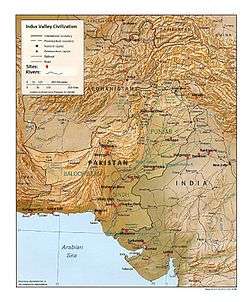Somb river
| Somb river | |
|---|---|
| Native name | सोम नदी |
| Other name(s) | Som river |
| Country | India |
| Basin | |
| Main source | Shivalik Hills, Haryana |
| Physical characteristics | |
| Discharge |
|
The Somb river, also spelled Som river (Hindi: सोम नदी) is a tributary of Yamuna in of Haryana state of India.[1]
Origin and route
The Somb river originates in the Shivalik hills near Adi Badri (Haryana) in Yamunanagar district on the border of Haryana and Himachal Pradesh State.
In 1875-76 Pathrala barrage at Dadupur was built where Somb river meets Western Yamuna Canal in Haryana.[2]
The basin is classified in two parts, Khadir and Bangar, the higher area that is not flooded in rainy season is called Bangar and the lower flood-prone area is called Khadar.[1]
Irrigation and Hydal Power
The Western Yamuna Canal has several check dams in Yamunanagar district and Hydal power is generated at Pathrala barrage.[2] some of which are also used for the hydel power generation.
Identification with Vedic rivers
The Adi Badri (Haryana) is a forest area and archaeological site in the foothills of Sivalik Hills in bhabar area situated in northern part of Yamunanagar district of north Indian state of Haryana. This is considered to be the originating point of vedic river Sarasvati(The point where the river leaves the mountains and enter plain land.[3][4][5][6]
Several modern scholars identify the old Ghaggar-Hakra River (of which Tangri river is a tributary) as the Sarasvati river and the Chautang river with the Drishadvati river of Vedic period, on the banks of which Indus-Sarasvati civilisation developed. such scholars include Gregory Possehl,[7] J. M. Kenoyer,[8] Bridget and Raymond Allchin,[9] Michael Witzel,[10] Kenneth Kennedy,[11] Franklin Southworth,[12] and numerous Indian archaeologists.
Gregory Possehl and Jane McIntosh refer to the Ghaggar-Hakra river as "Sarasvati" throughout their respective 2002 and 2008 books on the Indus Civilisation.[13][14]
Gregory Possehl states:
"Linguistic, archaeological, and historical data show that the Sarasvati of the Vedas is the modern Ghaggar or Hakra."[14]
Gallery
 Indus-Sarasvati civilisation major sites
Indus-Sarasvati civilisation major sites
See also
- Dangri, a tributary of Sarsuti, merge if Dangri and Tangri are same
- Sarsuti, a tributary of Ghaggar-Hakra River
- Kaushalya river, a tributary of Ghaggar-Hakra River
- Markanda river, Haryana, a tributary of Ghaggar-Hakra River
- Chautang, a tributary of Ghaggar-Hakra River
- Sutlej, a tributary of Indus
- Ganges
- Indus
- Western Yamuna Canal, branches off Yamuna
References
- 1 2 HaryanaOnline - Geography of Haryana
- 1 2 Western yaumna Canal Project
- ↑ Early Harappans and Indus Sarasvati Civilization, 2 Vols. by Sharma, D P and Madhuri Sharma (ed) 2006
- ↑ http://www.haryanatourism.gov.in/destination/yamunanagar.asp
- ↑ "Release Id :118384 - Excavation in search of Saraswati River". Press Information Bureau, Govt. of India. 25 April 2015. Retrieved 11 May 2015.
- ↑ http://timesofindia.indiatimes.com/india/Haryana-sweet-water-pools-fire-up-Saraswati-revival/articleshow/47218176.cms
- ↑ Possehl, Gregory L. (December 1997), "The Transformation of the Indus Civilization", Journal of World Prehistory, 11 (4): 425–472, doi:10.1007/bf02220556, JSTOR 25801118
- ↑ Kenoyer, J. M. (1997), "Early City-states in South Asia: Comparing the Harappan Phase and the Early Historic Period", in D. L. Nichols; T. H. Charlton, The Archaeology of City States: Cross Cultural Approaches, Washington: Smithsonian Institution Press, pp. 52–70, ISBN 1560987227
- ↑ Allchin, Bridget; Allchin, Raymond (1982), The Rise of Civilization in India and Pakistan, Cambridge University Press, p. 160, ISBN 978-0-521-28550-6
- ↑ Erdosy 1995, pp. 105, 318.
- ↑ Erdosy 1995, p. 44.
- ↑ Erdosy 1995, p. 266.
- ↑ McIntosh, Jane (2008). The Ancient Indus Valley: New Perspectives. ABC-CLIO. ISBN 978-1-57607-907-2.
- 1 2 Gregory L. Possehl (2002). The Indus Civilization: A Contemporary Perspective. Rowman Altamira. p. 8. ISBN 978-0-7591-0172-2.